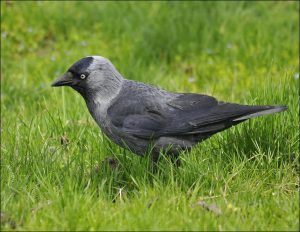It is as important to train the animal a signal but also when an animal should not do the behaviour this is called conditioning off cue. This is important so you to know that the animal really understands your signal. For example, if its more reinforcing for an animal to go in a transport box than it is to stay out of it, the balance of reinforcement might be leaning towards the transport box more than not going into it. We maybe should ask ourselves if generalization worked out well here?

Where it becomes more difficult is when we over or undervalue reinforcers for the animals we work with. I know stories where us trainers are too focused on food reinforcement and forget the other reinforcers that sometimes may be higher in value. One day on my run in the forest, I passed a Eurasian Jackdaw eating a Grass Snake. From a distance I could see that the bird was smacking the snake on a rock, which sparked my interest because of the tool use. When I approached to get a closer look, the Jackdaw left the snake and flew away to look at me from a distance. After this observation I wondered to myself, if the food source is so important and people would say is that food is the best reinforcer then why didn’t the Jackdaw stay instead? You see this type of behaviour a lot in animals who prefer to run away, like antelope species.
Imagine you have the right reinforcement for the animal you work with, you want the animal to touch one coloured target off over the another one. When they touch one target you don’t give anything, when the animal touches the right one you reinforce. What’s happening now is that the target that’s touched get’s a higher reinforcement history. The balance of reinforcement then gets higher for the target that is touched, we also call this differential reinforcement.
Another example is with a sea lion I’ve worked with, Cleveland. She would bite other people if she was incorrect with an asked behaviour. So I would ask her to go back in to her pen, if she wouldn’t go I would reinforce her 1 or 2 fish for staying with me instead of biting somebody. But when she would go in I reinforced her heavily. I tried to make the balance of reinforcement higher in her pen than on the outside.
If our balance of reinforcement is planned strategically and the whole team is on board than it might be that the variation is higher in reinforcement than the actual primary reinforcer. There is a lot of things to consider most importantly the species you work with. Killer whales and dolphins understand this variation very well but pinnipeds need some more time to get into The routine but it’s certainly not impossible.

Always consider the balance of reinforcement. Training our lions for the emergency recall is another another great example of the importance of balance of reinforcement. We do not ask this recall often, it’s not because we are lazy or do not have any time. It’s because the less we ask the bigger the difference, the better the response. When we would ask it more often we should reinforce more often. We want to have a strong response, therefore we do it less and can give them more variation in the amount of reinforcement and what kind of reinforcement we have for them. This only works with being unpredictable and thinking about the balance of reinforcement.
We have successfully trained several recalls at this point, below is a video of the elephants responding to a recall.
The balance of reinforcement is higher to go to the back areas than the enrichment device and curiosity it has to go there. We reached this goal by giving a lot more and different types of reinforcement and/or enrichment devices if they responded correctly.
When animals do not want to come inside, or when animals only use a part of their exhibit, or prefer one behaviour over the other, maybe the balance of reinforcement is not correct. Look at changing that and you might solve a lot of issues.




0 Comments